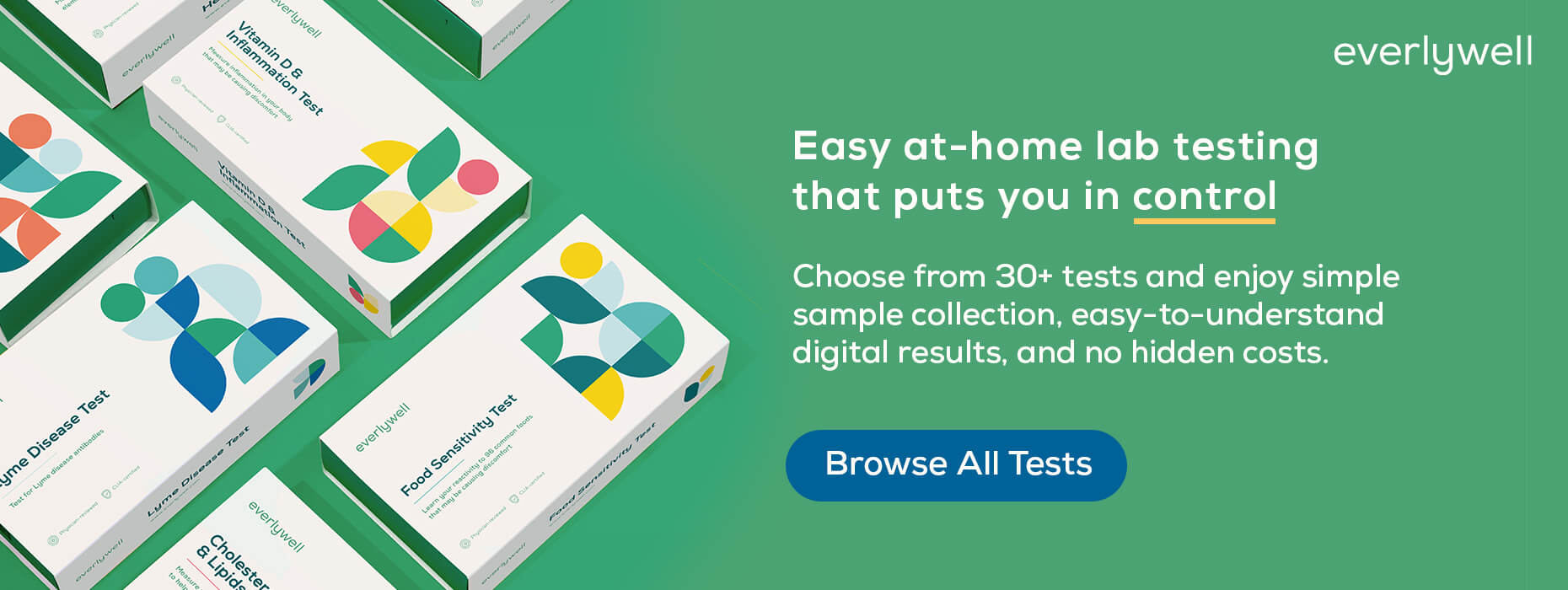
Is folate the same as folic acid?
Medically reviewed on March 8, 2022 by Jordan Stachel, M.S., RDN, CPT. To give you technically accurate, evidence-based information, content published on the Everlywell blog is reviewed by credentialed professionals with expertise in medical and bioscience fields.
When scanning the nutrition facts on the back of food packaging, you’re often treated to a list of nearly unpronounceable ingredients. Between vitamins, minerals, compounds, and additives, determining what’s in food can feel like reading a foreign language. And one particularly confusing set of terms? “Folate” and “folic acid.”
The two terms sound similar, but is folate the same as folic acid? Not exactly.
Folate is the overarching term for various forms of vitamin B9, while folic acid refers to the synthesized version of B9 found in many fortified foods and supplements [1].
Still a little confused? Don’t worry, there’s a lot to explore when it comes to folate, folic acid, and your health. This article will detail the differences between these two compounds and provide a little background to better understand each.
What is folate?
Folate is a water-soluble vitamin also known as vitamin B9 or folacin. Folate is a broad term that encompasses a variety of naturally and non-naturally occurring forms of vitamin B9. However, the term is most often used to refer to the naturally occurring variations of B9—separating it from synthetic folic acid.
Additionally, folate represents one of the 13 crucial vitamins that the body requires to function, grow, and flourish. These vitamins include [2]:
- Vitamin A
- Vitamin C
- Vitamin D
- Vitamin E
- Vitamin K
- Thiamine
- Riboflavin
- Niacin
- Pantothenic acid
- Biotin
- Vitamin B6
- Vitamin B12
What does folate do?
Folate is essential, but what does that mean for the body? Folate and folic acid—both providing vitamin B9—are synthesized by the body and used in several biological functions, including:
Cell division – One becomes two, two become four. Cell division and reproduction are essential for developing, repairing, and maintaining various tissues and organs. It takes a variety of essential compounds and nutrients to facilitate cell division, including folate [3].
DNA and genetic material – What makes you, you? Well, it’s more than a shining personality. Your biological components are written into DNA. To continue producing unique genetic material, the body needs regular doses of folate [3].
Can you have a folate deficiency?
While most Americans consume foods high in folate, folate deficiency is not unheard of, especially for the following groups:
Pregnant people – Those who are pregnant need about 50 percent more folate to help nourish their growing babies. Fortunately, this need is easily met with prenatal vitamins or other supplements recommended by a healthcare provider [4].
People with malabsorption disorders – Frequent alcohol use, celiac disease, and/or various gastric issues can all deeply impact the body’s ability to absorb folate. Despite one’s best efforts to include the vitamin in their diet, it’s all for nothing if someone is suffering from a malabsorption disorder [4].
Additionally, genetic predispositions may obstruct proper folate conversion from its ingested form into its active form. This can make it difficult for the body to properly use certain forms of the vitamin [4]. Consider exploring medical testing options and treatment if you suspect you’re unable to properly absorb folate.
What should you check for if you’re worried you’re not getting enough folate? A vitamin B9 deficiency may cause a variety of side effects, including:
Hypertension – Studies have indicated a relationship between blood pressure and folate. High blood pressure can drastically increase the risk for stroke, making folate especially important for those in high-risk categories [5].
Neural tube defects – Folate’s relationship to serious spine and brain birth defects is well documented. These birth defects most often appear in the earliest week of pregnancy, making it essential for those trying to conceive to begin a folate regime before pregnancy [6].
Depression – As strange as it sounds, this essential vitamin can have a helpful effect on mental health. In fact, low folate levels have been linked to depression. Additionally, folate may have an impact on antidepressant medication effectiveness [3]. Those dealing with chronic depression should consult their healthcare provider to ask about potential interactions between medications and folate.
Folate research has also investigated connections to cancer, autism spectrum disorder, and dementia, but current findings are inconclusive. When examining the effects of naturally occurring folate versus synthetic folic acid, the data becomes increasingly uncertain [3].
What is folic acid?
Folic acid isn’t found in nature like folate. It was synthesized by humans and has been a component of the diet for several decades. You can think of folic acid as a scientific breakthrough designed to provide more vitamin B9 to the population. Essentially, it performs the same functions as folate within the body, with minor differences in biological synthesis.
Folic acid is most often found in supplements and enriched foods, such as:
- Oral vitamins
- Breakfast cereals
- Corn flour
- Bread and baked goods
- Pasta
- Cornmeal
- Rice
The enrichment of food with various vitamins and minerals has occurred for several decades. In the 1940s, the federal government began issuing enrichment requirements for flour to combat vitamin B deficiencies [7]. The enrichment program continues to affect food production today and provides Americans with easy access to essential vitamins.
Many food producers have voluntarily added folic acid to their products in accordance with Food and Drug Administration (FDA) regulations [7]. Chances are your cabinets are stocked with enriched food products right now.
Folic acid supplements
While most Americans consume their daily folic acid from the foods they eat, there are several dietary supplements designed to deliver vitamin B9. Oral multivitamins and specialized B-complex vitamins offer an easy way to hit the daily requirements without making major dietary changes.
It’s important to note, supplements are less effective when taken sporadically, so ensure that you stick to a daily regimen to see the full effects and benefits of folic acid supplements.
Daily folic acid requirements
Curious about the proper daily dosage of folate? Keep the following points in mind when examining daily requirements:
400 micrograms – Folate is measured in micrograms (mcg) of dietary folate equivalents (DFEs). The recommended dose for adults is 400 micrograms of folic acid every day. This number was established as a threshold for preventing various health risks, as well as potential birth defects. Children require a lower amount of folic acid, slowly increasing as they age [8].
Folate vs. folic acid concentration – All vitamin B9 is not the same. Folic acid is more easily absorbed by the human body, meaning a smaller amount goes further. Approximately 250 micrograms of folic acid are equal to 400 micrograms of folate, making folic acid the more efficient way to fulfill nutritional requirements [8].
Unsure where to get your daily recommended dose of vitamin B9? Both folate and folic acid are safe and effective ways of providing the body with the nutrition it needs. Whether you’re munching on leafy greens, ingesting a supplement, or enjoying a bowl of your favorite enriched breakfast cereal, your body will appreciate it.
It’s also important to note, the body may not use all the folic acid consumed, and that’s just fine. Normal levels of unmetabolized folic acid have not been linked to any serious health effects. Typically, unused folic acid is sent to the kidneys and expelled through urine [9].
Risks from excessive folic acid
Sometimes, you can have too much of a good thing. The health hazards of consuming significantly more than the daily recommended amount of vitamin B9 are only partially understood, but it’s best to play it safe. Stick to the standard 400 micrograms per day unless otherwise informed by a healthcare provider.
What are the risks of consuming excessive folic acid? A few correlated health problems include:
Cognitive impairment – Research has suggested that excessive levels of vitamin B9 in the bloodstream may influence cognition and could play a role in degenerative brain diseases like dementia and Alzheimer’s [9].
Pernicious anemia – A rare blood problem that’s most associated with low levels of vitamin B12, pernicious anemia can cause nervous system damage if left unchecked [9]. Side effects of anemia include fatigue and exhaustion, along with organ and tissue damage. However, with treatment and proper care, you can expect to make a full recovery from anemia.
These health risks have only been associated with extremely high doses of folic acid (more than 5,000 micrograms), making it highly unlikely one will ever experience these issues [9]. However, a good rule of thumb to keep in mind is this: don’t consume more than 12 times the daily recommended dosage of vitamin B9.
References
1. General Information About NTDs, Folic Acid, and Folate. Centers for Disease Control and Prevention. URL. Accessed March 8, 2022.
2. Vitamins and Minerals for Older Adults. National Institutes of Health. URL. Accessed March 8, 2022.
3. Folate Fact Sheet for Consumers. National Institutes of Health. URL. Accessed March 8, 2022.
4. Cells. National Institutes of Health. URL. Accessed March 8, 2022.
5. Folate: Fact Sheet for Health Professionals. National Institutes of Health. URL. Accessed March 8, 2022.
6. Folic Acid and Its Link to Other Health Outcomes. Centers for Disease Control and Prevention. URL. Accessed March 8, 2022.
7. General Information About NTDs, Folic Acid, and Folate. Centers for Disease Control and Prevention. URL. Accessed March 8, 2022.
8. Folic Acid Fortification and Supplementation. Centers for Disease Control and Prevention. URL. Accessed March 8, 2022.
9. Folic Acid Recommendations. Centers for Disease Control and Prevention. URL. Accessed March 8, 2022.
10. Folic Acid Safety, Interactions, and Effects on Other Outcomes. Centers for Disease Control and Prevention. URL. Accessed March 8, 2022.
